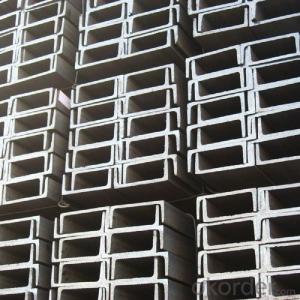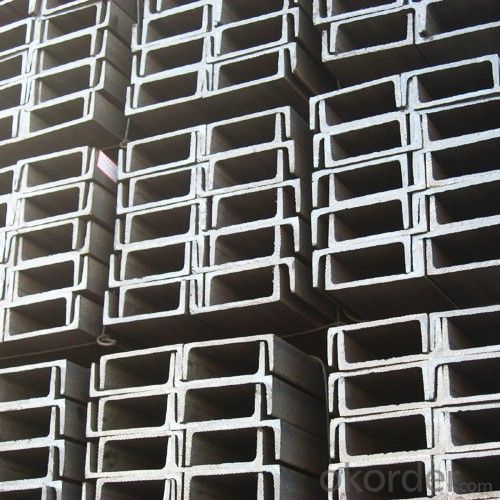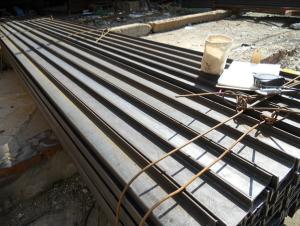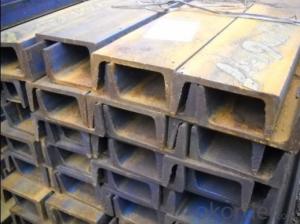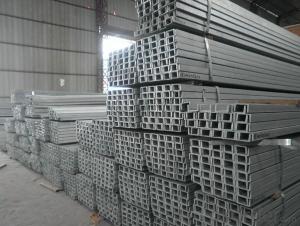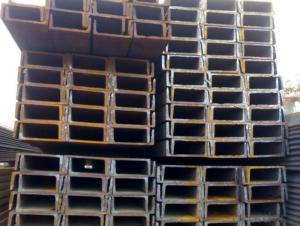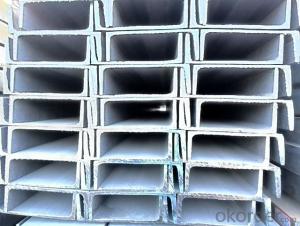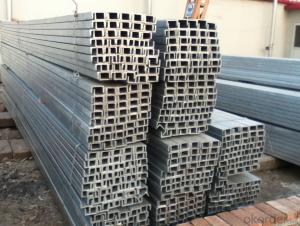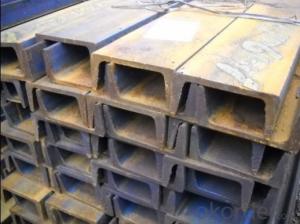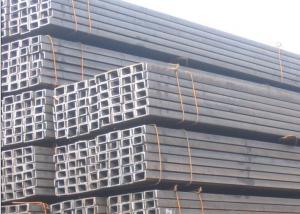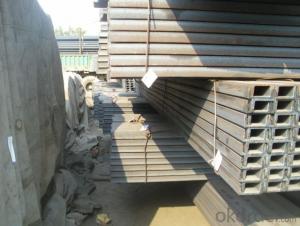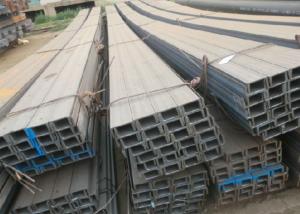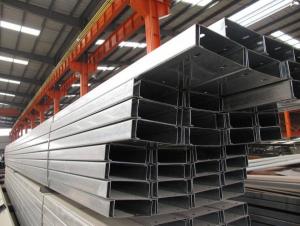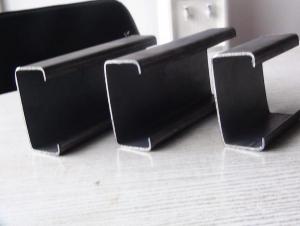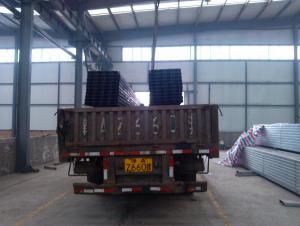100*50*6.0mm JIS U CHANNEL for CONSTRUCTION
- Loading Port:
- Tianjin
- Payment Terms:
- TT OR LC
- Min Order Qty:
- 25 m.t.
- Supply Capability:
- 10000 m.t./month
OKorder Service Pledge
OKorder Financial Service
You Might Also Like
Product Description:
Steel U Channel Details:
Minimum Order Quantity: 25 Tons Unit: m.t. Loading Port: Xingang Port
Supply Ability: 1000 Tons Per Day Payment Terms: TT or L/C
Product Description:
Specifications of Steel U Channel:
Standard Applied: GB Standard, EN Standard(UPN), JIS Standard
Sizes: 50mm to 300mm
Material Grade: Q235B, Q345B, S235JR, SS400, ASTM A36
As shown in the figure:
| JIS U CHANNEL | Standard h | Sectional b | Dimension s | t | Mass: Kg/m |
| (mm) | (mm) | (mm) | (mm) | ||
| 50x25 | 50 | 25 | 3.0 | 6.00 | 2.37 |
| 75X40 | 75 | 40 | 3.8 | 7.00 | 5.30 |
| 75X40 | 75 | 40 | 4.0 | 7.00 | 5.60 |
| 75X40 | 75 | 40 | 4.5 | 7.00 | 5.85 |
| 75X40 | 75 | 40 | 5.0 | 7.00 | 6.92 |
| 100X50 | 100 | 50 | 3.8 | 6.00 | 7.30 |
| 100X50 | 100 | 50 | 4.2 | 6.00 | 8.03 |
| 100X50 | 100 | 50 | 4.5 | 7.50 | 8.97 |
| 100X50 | 100 | 50 | 5.0 | 7.50 | 9.36 |
| 125X65 | 125 | 65 | 5.2 | 6.80 | 11.66 |
| 125X65 | 125 | 65 | 5.3 | 6.80 | 12.17 |
| 125X65 | 125 | 65 | 5.5 | 8.00 | 12.91 |
| 125X65 | 125 | 65 | 6.0 | 8.00 | 13.40 |
| 150x75 | 150 | 75 | 5.5 | 7.30 | 14.66 |
| 150x75 | 150 | 75 | 5.7 | 10.00 | 16.71 |
| 150x75 | 150 | 75 | 6.0 | 10.00 | 17.90 |
| 150x75 | 150 | 75 | 6.5 | 10.00 | 18.60 |
Usage/Application of Steel U Channel:
The steel u channel can be applied to construction of warehouses, workshops, sport stadiums and car parks etc. In details, the steel u channel belongs to carbon structural steel which is applied to in the field of construction and machinery. The steel u channel is usually used for arch-itechtural structure, and they could be welded in order to support or hang a vari-ety of facilities. They are also usually used in combination with I beam. Generally,the steel u channel must possess perfect welding property, riveting property and mechanical property and so on.
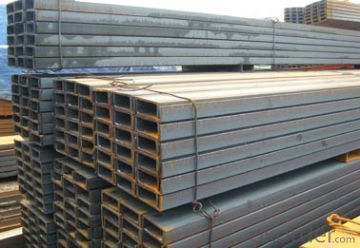
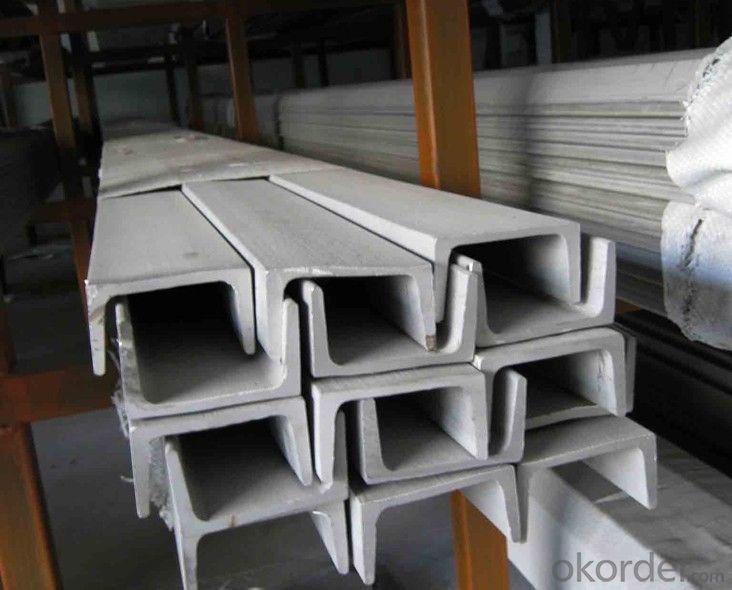
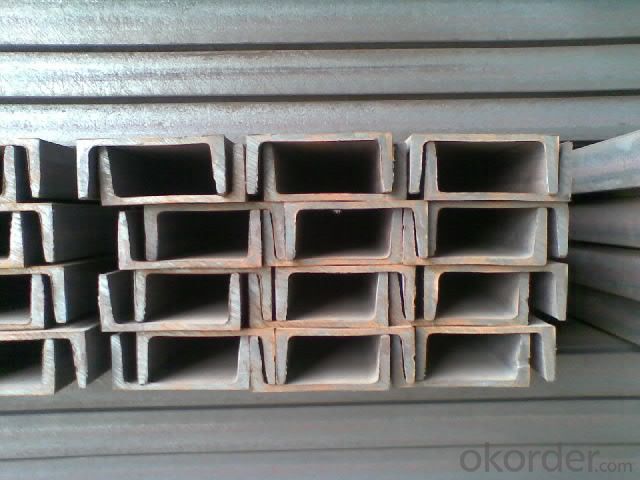
Package & Delivery: Steel U Channel
The steel u channel will be packed in bundle with steel wire at each end of every bundle and color marking in order to help the customer to recognize his goods more easily at sight.
And steel u channel could be loaded into 20ft or 40ft container, or by bulk cargo. If the weight of each bundle reaches less than 3.5 mt, the loading by break bulk cargo should be choosed. When the weight of each bundle reaches less than 3mt, the loading by container should be choosed.
As for the transportaion from mill to loading port, the truck will be usually used. And the maximum quantity for each truck is 40mt.
All in all, we could do in accordance with customer's request
- Q: I have three houses, the length is 7 meters, the width is 4 meters, I would like to use a 4 meter trough board to do the support, and then put concrete slabs on the channel, the two floor of the roof also do so, can I do that? If it is possible to use a large trough plate, a thick concrete slab, and a thick steel bar for concrete slabs Thank you
- Channel steel, of course, when the beam, the best 3600*3600mm, plate thickness of 100mm, reinforced two-way double 8@200, grade three steel
- Q: How do steel channels perform in high-temperature environments?
- Due to their inherent strength and durability, steel channels are known to excel in high-temperature settings. Steel possesses properties, like a high melting point and resistance to thermal expansion, that make it a suitable material for elevated temperatures. When exposed to high heat, steel channels can withstand it without significant deformation or loss of structural integrity. One of the primary reasons why steel channels are effective in high-temperature environments is their capacity to maintain their mechanical properties even at elevated temperatures. Steel has a high thermal conductivity, allowing it to efficiently dissipate heat and prevent excessive temperature rise. This quality helps to preserve the structural stability of steel channels when faced with high heat. Furthermore, steel channels are often designed with a high fire resistance rating. This is accomplished by incorporating fire-resistant coatings or fireproofing materials to enhance their performance in extreme temperatures. These measures safeguard the steel channels from the adverse effects of heat, such as weakening or deformation. It is important to recognize that the performance of steel channels in high-temperature environments may be influenced by factors like the specific grade of steel used and the duration of exposure to elevated temperatures. Various grades of steel possess different thermal properties, so it is vital to select the appropriate grade based on the temperature requirements of the particular application. In conclusion, steel channels generally demonstrate excellent performance in high-temperature environments. Their strength, durability, and ability to retain mechanical properties make them well-suited for use in such conditions. However, it is advisable to consult experts or refer to the manufacturer's specifications to ensure that the steel channels are chosen and utilized correctly for optimal performance in high-temperature environments.
- Q: Difference between light channel steel and ordinary channel steel
- The difference is that the light channel steel is smaller than the ordinary channel steel, the actual weight is lighter, and the price is cheaper.
- Q: Can the bypass of the overhanging layer on the site be made of channel steel? How can I put the channel steel, if possible?
- Reinforcement measures shall be taken if the floor thickness is less than 120mm. 6.10.9 the cantilever beam spacing shall be set by the vertical distance of the vertical pole of the cantilever frame, and each vertical distance shall be provided with one root. 6.10.10 the outer bracing of the cantilever shall be set up from bottom to top. The scissors support shall comply with the provisions of articles 6.6.2 and 6.6.5 of this code.
- Q: How are steel channels protected against corrosion in marine environments?
- Various methods are utilized to protect steel channels from corrosion in marine environments. Among these methods, the application of protective coatings is widely employed. These coatings create a barrier that shields the steel from the corrosive elements present in marine environments. Epoxy coatings are commonly used for marine applications due to their exceptional resistance against saltwater and other corrosive agents. Another approach to safeguard steel channels in marine environments is through cathodic protection. This technique involves the utilization of sacrificial anodes, which are made from a more reactive metal like zinc or aluminum. These anodes are affixed to the steel channels and intentionally corrode in place of the steel. By doing so, they divert the corrosive elements away from the steel channels, effectively preventing their corrosion. Furthermore, it is crucial to conduct regular maintenance and inspections on the steel channels in order to prevent corrosion in marine environments. This entails routine cleaning of the channels to eliminate any marine growth or debris that could trap moisture and accelerate corrosion. Additionally, inspections should be carried out to identify any signs of corrosion or damage, allowing for prompt repairs or replacement of affected areas. To summarize, the protection of steel channels from corrosion in marine environments involves the application of protective coatings, cathodic protection, and regular maintenance and inspections. These measures play a vital role in prolonging the lifespan of the steel channels and ensuring their structural integrity in the challenging conditions of marine environments.
- Q: Can steel channels be used for balcony railings?
- Balcony railings can indeed utilize steel channels. With their strength and durability, these channels offer ideal support and safety features for balconies. Their dimensions and design can be easily customized to meet specific requirements. Moreover, steel channels have excellent resistance to corrosion and can endure harsh weather conditions, proving their reliability for outdoor usage. Whether for residential or commercial purposes, steel channels present a versatile and visually appealing choice for balcony railings.
- Q: Installation of floor type distribution box, foundation channel production and installation, the quota should choose which two?
- Floor type distribution box installation cannot apply the distribution cabinet installation, and should set floor type of distribution box installation quota; installation set foundation channel steel foundation channel steel installation item.The foundation channel steel production: the foundation channel steel is not installed item containing material, quantity of steel plate, galvanized flat steel, round steel is installed base grounding of the auxiliary channel and. To calculate the foundation channel steel production, making composite iron production, the quantity of round bar, angle steel, flat steel can be unified to channel.
- Q: Can steel channels be used for building facades?
- Indeed, building facades can utilize steel channels effectively. In construction, steel channels are frequently employed due to their exceptional strength and durability. These channels serve to frame and bolster building facades, ensuring structural integrity and stability. By virtue of their adaptability, steel channels can be effortlessly customized and fabricated into diverse forms and dimensions to meet the facade's design specifications. Moreover, steel channels can undergo coating or finishing processes to augment their visual appeal and safeguard against corrosion, rendering them appropriate for both functional and aesthetic purposes in building facades.
- Q: What are the design considerations for steel channels?
- Some design considerations for steel channels include the load capacity, structural stability, corrosion resistance, and compatibility with other building materials. Additionally, factors such as the intended use, environmental conditions, and cost-effectiveness also play a role in the design process.
- Q: Can steel channels be used for support beams?
- Yes, steel channels can be used for support beams. Steel channels are commonly used for structural purposes, including supporting heavy loads. They provide strength, durability, and stability, making them suitable for various construction projects, such as bridges, buildings, and industrial structures.
Send your message to us
100*50*6.0mm JIS U CHANNEL for CONSTRUCTION
- Loading Port:
- Tianjin
- Payment Terms:
- TT OR LC
- Min Order Qty:
- 25 m.t.
- Supply Capability:
- 10000 m.t./month
OKorder Service Pledge
OKorder Financial Service
Similar products
Hot products
Hot Searches
Related keywords
